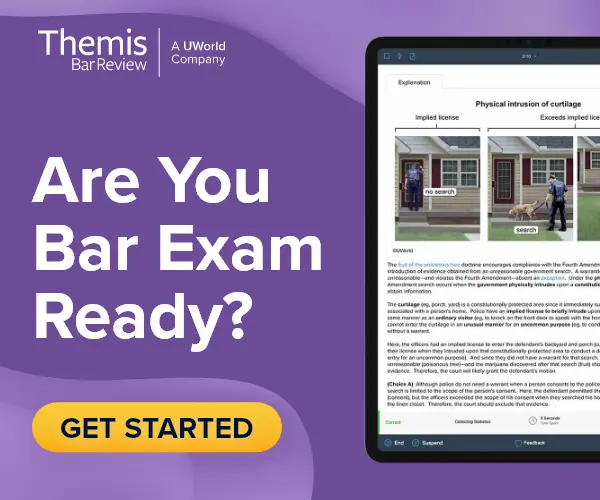Pursuing a career in law involves years of rigorous education, followed by the challenge of passing the bar exam. Reaching that goal of becoming a lawyer in the U.S. offers many benefits, including high earning potential, the ability to impact people’s lives positively, and the opportunity to develop strong analytical and critical thinking skills in a respected professional career path.
What sets successful lawyers apart from the more than 1.3 million who practice law in the U.S.? Planning. From law school selection to bar exam preparation, each choice can help shape your career trajectory. It’s important to clearly understand the path that awaits you when you decide to pursue a career in law.
Path to Becoming a Lawyer
There are various paths to becoming a lawyer, but here’s the most common one:
- Obtain a bachelor's degree
- Pass the JD-Next™ or LSAT®
- Obtain a Juris Doctor (JD)
- Complete the Multistate Professional Responsibility Examination (MPRE®)
- Pass your state's bar exam
Obtain a Bachelor's Degree
A bachelor’s degree is a prerequisite for admission to an accredited law school to earn a JD. Your major doesn’t matter, but you must perform well in your courses. There are a few degrees, though, that undergraduates who want to go to law school prefer:
| Political science | Psychology |
| Criminal justice | English |
| Economics | History |
| Arts and humanities | Philosophy |
| Sociology | Communications |
While you may pursue any major you’re interested in, the American Bar Association (ABA®) recommends cultivating these skills in your classes, internships, extracurriculars, and summer jobs to give you an advantage in applying:
| Problem-solving | Critical reading |
| Writing and editing | Oral communication and listening |
| Research | Organization and management |
| Public service and promotion of justice | Relationship-building and collaboration |
| Background knowledge | Exposure of the law |
Your GPA will be a factor in determining which law schools will accept you into their program. While never guaranteed, admission to a top 10 law school requires a minimum 3.59 GPA. You can get into a law school with a 2.9 GPA, but your options likely will be limited.
Pass the JD-Next and/or LSAT
JD-Next and LSAT are the standardized admission tests that law schools accept. They assess all the skills required during the first year of law.
JD-Next is an 8-week course proctored 4 times a year. It consists of 2 components — 80 multiple-choice questions over 4 hours followed by an ungraded 30-minute essay. The program, which bridges the gap between academic preparation and real-world application, culminates in a comprehensive and standardized assessment that prospective students can use to apply for law school. The JD-Next assessment aligns with the vision of the NextGen Bar Exam, which will debut in 2026 “using a focused set of legal concepts and principles.”
The LSAT is proctored 9 times a year and has about 100 multiple-choice questions and an essay. It currently is the most widely accepted exam for law school admissions. JD-Next, however, is rapidly gaining traction, with more than 20% of U.S. law schools receiving a variance from the ABA to accept JD-Next test results in lieu of the LSAT.
Obtain a Juris Doctor
JD programs are intensive and require 3 years of full-time study. But nearly all students who take the bar exam within 2 years of graduating from an ABA-accredited law school pass. To increase your chances of successfully making it through law school, here are some actionable tips:
Graduating with a JD from an ABA- or state-board-accredited law school is required to sit for the bar exam in all jurisdictions except California, Vermont, Virginia, and Washington. Review the National Conference of Bar Examiners (NCBE) guide to bar admission requirements and exceptions.
Complete the MPRE
The MPRE, administered by the NCBE, assesses your knowledge of professional codes of conduct for the legal industry as outlined in the Model Rules of Professional Conduct and the Model Code of Judicial Conduct. It is administered 3 times per year. The 2-hour exam has 60 multiple-choice questions, including 10 unscored pilot questions for future exams.
The MPRE is usually taken before sitting for the bat exam, but some states allow candidates to take it after passing the bar. MPRE passing scores vary by state. The MPRE is not required to practice law in Wisconsin and Puerto Rico.
Pass Your State Bar Exam
Forty-one jurisdictions have adopted the Uniform Bar Examination (UBE®). It has 3 components administered over 2 days: the Multistate Performance Test (MPT®), the Multistate Essay Examination (MEE®), and the Multistate Bar Examination (MBE®). Non-UBE jurisdictions have combined 1 or more components of the UBE, such as the MBE, with a state-specific essay component. Check your state’s Board of Bar Examiners or Supreme Court website to ensure you meet all the requirements and deadlines.
Pass rates for the bar exam vary by state. Bar exam applicants spend up to 400 hours studying. Proper planning ensures that you will pass on the first attempt. Check out these tips on studying for the bar exam.
Bar exam reciprocity
Bar exam reciprocity refers to the portability of an exam score from 1 jurisdiction to another. Some states, such as Hawaii, don't offer reciprocity. Others, including Colorado, have reciprocity with most states. Taking the UBE makes your score more portable to participating jurisdictions. However, each jurisdiction has different minimum passing scores. Your transfer score must typically meet that threshold.
What's Next After Passing the Bar?
Upon passing the bar, you will take an oath in court and be sworn in as a lawyer. If any additional state requirements or tests are necessary, you’ll fulfill them then. Now, you’re ready to practice law.
| Apply for a Job | Contact your law professors for recommendations and job opportunities. Your law school likely will have a career services center with resources to help you find a job. |
| Attend State Bar Association Mixers | Attend state bar association events where you meet practicing lawyers. |
| Maintain Licensure | Fulfill the Continuing Legal Education (CLE) requirements to maintain licensure. These vary per state, with some requiring 25 to 45 hours every 3 years. |
Becoming a Lawyer as an International Student
Practicing law in the U.S. is possible even if you’ve received your legal education in a foreign country. The requirements vary depending on the jurisdiction. For example, some require additional education for internal students. Others permit admission for examination based on legal work experience. Check the list of states that allow international students to take the bar exam.




